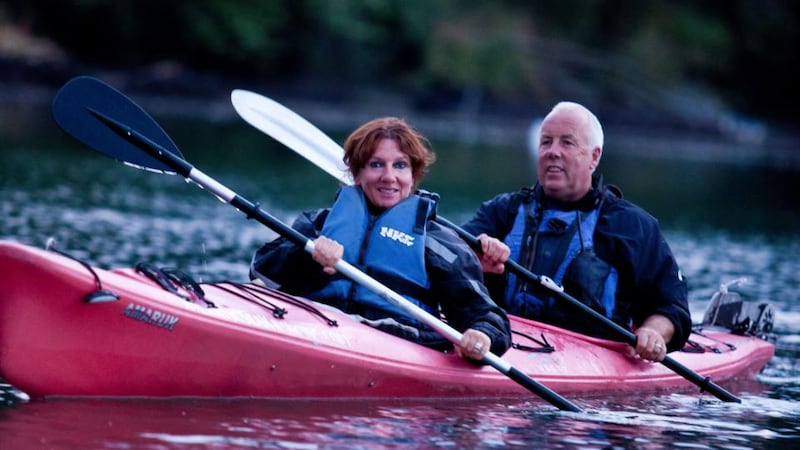The stretch of coastline from the fishing village of Union Hall, on the west side of Glandore Harbour in Co Cork, to Ring Head, overlooking Clonakilty Bay, spills into the Atlantic Ocean like an ink blot. As the crow flies the distance is not much more than 20km, but the dull trajectory of a crow has little bearing on this enthralling, menacing and breathtakingly magnificent shoreline.
It is hedged by red fuchsia, wild pink roses, yellow gorse, purple hydrangeas, and rose hips the size of small apples, and its winding cliff paths overlook the Atlantic. A traveller on this route prior to 1755 would have walked an entirely different terrain: ancient maps of the area show the sea running up to Rosscarbery Castle, but an earthquake in Lisbon that year caused a tsunami, which hit the southern coast of Ireland, depositing vast amounts of sand and shale, and now the coast unravels itself over marshes and flats and long stretches of yellow beaches.
Fall in love with west Cork and you’re in for a long, tricky marriage. Alluringly beautiful, she has known more than one admirer. In the 1960s the Dutch and the Germans came, with their long blond plaits and pottery wheels and lofty (if prescient) notions of sustainability. They were followed by a rattlebag of alternative types, among them American occultists looking for a gateway to the fourth dimension and, attracted by Charlie Haughey’s abolition of tax liability for artists, a plethora of novelists, poets, and folk sporting beards and rhyming couplets.

There are still plenty of painters, potters, healers and scribes scattered about the low green hills. But this is a busy community and, during my visit on a hot weekend, combine harvesters work the fields, saving the hay, until midnight, and fat black cows graze on Inchydoney Island, destined for the butcher shops of Clonakilty.
In good hands
I have two guides for my journey from Union Hall to Ring: local artist and Clonakilty native Geraldine O'Sullivan, whose own history is entwined in the landscape she paints, and the energetic, erudite and deeply knowledgeable Jim Kennedy, proprietor of Atlantic Sea Kayaking.
We begin our trip by kayak, paddling out from Squince Harbour on a sun-drenched morning. Our plan is to kayak as much of the route as possible, a trip that in fair weather would take about two days. But the ocean has no tolerance for deadlines, and, although inland, you could fry eggs on stone, the sea has her own ideas.
From Squince you can almost reach out to touch Rabbit Island and, just beyond, at the mouth of Union Hall, Adam and Eve islands, where the trawler Tit Bonhomme perished in January 2012, with the loss of five lives. The boat was just two kilometres short of the harbour. On a bright, apparently benign morning, it is almost impossible to believe that tragedy could happen so close to the shore.
We paddle out of the cove through a labyrinthine corridor of black rocks, reaching open water as the sea begins to twist. We wait, watch the fetch of the water where the wind hits the waves. Jim Kennedy is a level-five kayaking instructor, and safety is his creed, so we turn back. The wind has blown up to a force-five in minutes.
The waters darken
"Avoid Adam, hug Eve" goes the local advice about the islands where the Tit Bonhomme went down. As we pull the boats up over the shale, we talk about the disaster, the vigil on the pier at Union Hall, solidarity and grief and respect, and about a community that pulled together at a time of heartbreak. Behind us, the waters darken.
Over the next two days we walk and kayak. Through prosperous Glandore, where SUVs choke the narrow roads and yachties in canvas trousers sip gin as the sun sets. On past Goat’s Head, Tralong Bay, Mill Cove, Castle Bay, and coves guarded by jagged rocks that pierce the coast like snarling teeth. At the Blue Flag beach on Rosscarbery Bay, overlooked by Downeen Tower, the vista opens out and we get our first view of Galley Head lighthouse.
This coast is studded with seaside farmhouses. O’Sullivan points out the iron buoys decorating pillar tops, the sea glass and shells decorating garden walls. These dwellings sit alongside newly built holiday homes. For the most part these new developments, largely owned by Irish and English families, are palatable enough.
At Owenahincha, however, a populous, caravan-dotted stretch of coast, we encounter a gated community, cowering under the gaze of inquisitive seagulls, its electronic entrance box dangling open, belching wires. It probably seemed like a good idea at the time.
O’Sullivan remembers when Owenahincha welcomed the Ford factory workers who used to holiday there in the 1960s and 1970s, before industrial closures and cheap flights.
We poke around the graffitied corpse of an old German-owned motel. Hunched chrome shoulders protrude from overgrowth: the ladder of the outdoor swimming pool. Net curtains cover cavernous windows and broken white crockery peppers the ground like snow. “Moira is bald,” reads a lonely scrawl by the old entrance.
We leave the ghosts and continue along the shore, taking in Long Strand, an unbroken stretch of coast beloved of surfers, onwards to Galley Head lighthouse and Red Strand, where families picnic and the sun carpets the sea like a runway.
All around Clonakilty Bay, the beaches have their own character: Sands Cove, home to an annual fishing festival, where fish is barbecued for the whole community; Dunnycove, the only safe anchorage between Glandore and Ring, where the copper-stained slipway is the same colour as the turquoise sea; Duneen strand, where miniature ponies and Shetlands canter on the spongy grass above the shore.
And then there's the causeway over to Inchydoney Island, past White's Marsh, where the American second World War B17 bomber Tain't a Bird came down in 1943. The crew and their mascot, a monkey called Tojo, moved into O'Donovan's Hotel in Clonakilty, where the monkey, having survived the attentions of the German Luftwaffe, caught a cold and died. He is buried underneath the floorboards of the dance hall.
As we cross Inchydoney Island, the sulky races are in full flight: horses pulling lightweight chariots and drivers race up the green hill and down again, while a man with a megaphone roars at the sun.
Eventually we reach Ring, a tidal harbour with two piers, our final destination. We walk the cliffs to a point where we can look out towards Simon’s Cove, Ballinglannon, Dunworley and, as far as the eye can see, the Seven Heads, and in the foreground, a series of elegant arches where the sea burrows into the cliff.
Unfinished business
It is journey's end, but Jim Kennedy and I have unfinished business. Kennedy's knowledge of, and enthusiasm for, this landscape is boundless. There is so much more we could do: go foraging for seaweed, or head off in search of seals and whales and dolphins and basking sharks that come in to feed from this buffet where the wild Atlantic first meets land. In the end we retrace our steps, settling for a twilight kayak on Castlehaven Bay near the beautiful Castletownshend.
As night falls we paddle in almost perfect silence. The water is warm, the night clouds appear luminous, a heron glides from a forest of trees that dip and bend into the water. Otters slip into the drink from the black shore, phosphorescence dripping from our quiet oars.
It seems risible to explore this coast over a single weekend, almost a crime. This is terrain that deserves a lifetime.
Bay watch: from Union Hall to Ring
The stretch of coastline from the fishing village of Union Hall on the west side of Glandore Harbour, to Ring Head, overlooking Clonakilty Bay, measures 20km in length in a straight line.
The coastline was reformed when a tsunami hit Lisbon in the mid-18th century, depositing sand and shale along the west Cork coastline and helping give it the shape we see today. It’s a coastline dotted with picturesque fishing villages, long stretches of beach, and pretty inland country towns and villages, with a sizeable sprinkling of islands, such as Rabbit Island, Adam and Eve Island and Inchydoney Island.
Notable bays include Castlehaven Bay, Clonakilty Bay and Rosscarbery Bay, and one of the most striking man-made interventions on the coastline is the Galley Head Lighthouse (below), which can be rented through the Irish Landmark Trust (irishlandmark.com). Inchydoney Strand, a long Blue Flag beach near the town of Clonakilty, is rightly rated as one of Ireland’s best, while the nearby hotel and spa have been sensitively developed.
Attractions and activities
The sheltered bays and historical inlets dotted along this coastline make kayaking an ideal way to explore the area, and Jim Kennedy at Atlantic Sea Kayaking offers a range of tours and services, from marine safaris to coastal walks, whale watching to seaweed foraging.
Artist Geraldine O’Sullivan hosts an exhibition of new work at her Castlefreke home this Saturday and Sunday.
On the music front, Liss Ard Estate in Castletownshend hosted low-key music festivals in the 1990s, but it has now been renovated and opened up to guest accommodation. A big draw is James Turrell’s sky garden, which has an admission charge and guided tours.
For live music, the best spot is probably De Barra’s Folk Club in Clonakilty, which recently celebrated 30 years of hosting music from the likes of John Spillane, who plays monthly. As Christy Moore put it: “There’s Carnegie Hall, the Royal Albert, Sydney Opera House, and then there’s De Barra’s.”
There are good food options along the coast, with seafood and local produce a particular draw. Deasy’s Harbour Bar and Seafood Restaurant in Ring, which overlooks the water, serves dinner Wednesday to Saturday, 6pm to 9.30pm, while the Glandore Inn is a good spot to watch boats sail into the harbour.

















